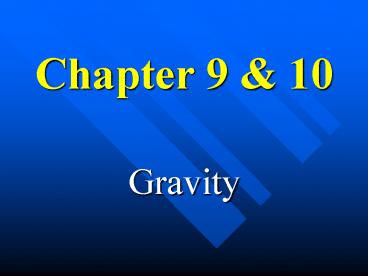Gravity - PowerPoint PPT Presentation
Title: Gravity
1
Chapter 9 10
- Gravity
2
Pythagoras (550 BC)
- Claimed that natural phenomena could be described
by mathematics
3
Aristotle (350 BC)
- Asserted that the universe is governed by
physical laws
4
- The ancient Greeks believed that the earth was at
the center of a revolving sphere with stars on it.
5
- The Geocentric Model implies Earth-Centered
Universe.
6
(No Transcript)
7
Copernicus (1500's)
- Developed a mathematical model for a Sun-centered
solar system
8
(No Transcript)
9
Tycho Brahe (1500's)
- Made precise measurements of the positions of the
planets
10
Kepler (1600's)
- Described the shape of planetary orbits as well
as their orbital speeds
11
(No Transcript)
12
Keplers First Law
- The orbit of a planet about the Sun is an ellipse
with the Sun at one focus.
13
Keplers Second Law
- A line joining a planet and the Sun sweeps out
equal areas in equal intervals of time.
14
Keplers Third Law
- The square of a planet's orbital period is
proportional to the cube of the length of its
orbit's semimajor axis. - Or simply T2 R3 if T is measured in years
and R is measured in astronomical units.
15
An Astronomical Unit...
- is the average distance of the Earth from the
Sun. - 1 AU 93,000,000 miles 8.3 lightminutes
16
Keplers Laws
- These are three laws of physics that relate to
planetary orbits. - These were empirical laws.
- Kepler could not explain them.
17
Keplers Laws...Simply(See page 192.)
- Law 1 Elliptical orbits
- Law 2 Equal areas in equal times
- Law 3 T2 R3
18
Newtons Law of Universal Gravitation
- From Kepler's 3rd Law, Newton deduced inverse
square law of attraction.
- G6.67 10-11 N m2/kg2
19
Gravity Questions
- Did the Moon exert a gravitational force on the
Apollo astronauts? - What kind of objects can exert a gravitational
force on other objects? - The constant G is a rather small number. What
kind of objects can exert strong gravitational
forces?
20
Gravity Questions
- If the distance between two objects in space is
doubled, then what happens to the gravitational
force between them? - What is the distance is tripled?
- is quadrupled?
- What if the mass of one of the object is doubled?
- tripled?
- quadrupled?
21
Weight and Weightlessness
- Weight
- the force due to gravity on an object
- Weight Mass ? Acceleration of Gravity
- W m g
- Weightlessness - a conditions wherein
gravitational pull appears to be lacking - Examples
- Astronauts
- Falling in an Elevator
- Skydiving
- Underwater
22
Ocean Tides
- The Moon is primarily responsible for ocean tides
on Earth. - The Sun contributes to tides also.
- What are spring tides and neap tides?
23
Spring Tides
Sun
Earth
New Moon
Full Moon
24
Neap Tides
First Quarter
Sun
Earth
Last Quarter
25
End of Section
26
Einsteins Theory of Gravitation
- Einstein perceived a gravitational field as a
geometrical warping of 4-D space and time.
27
BLACK HOLES
- Lets observe a star that is shrinking but whose
mass is remaining the same. - What happens to the force acting on an
indestructible mass at the surface of the star?
SFA
28
Remember that the force between the two masses
is given by
R
R
R
R
29
BLACK HOLES
- If a massive star shrinks enough so that the
escape velocity is equal to or greater than the
speed of light, then it has become a black hole. - Light cannot escape from a black hole.
30
Near a Black Hole































